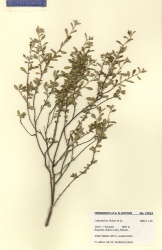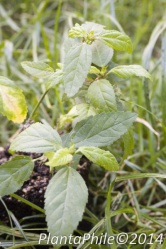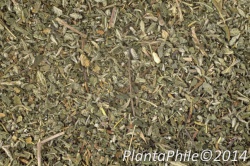|
AHPA recognizes other valuable resources exist regarding the identity of Turnera diffusa.
To submit a suggestion or contribution, please contact Merle Zimmermann.
|
Nomenclature
Turnera diffusa Willd. ex Schult. var. diffusa Turneraceae
Standardized common name (English): damiana
Botanical Voucher Specimen
 |
|

Source: MOBOT, Tropicos.org[1]
|
Organoleptic Characteristics
[Turnera diffusa (leaf)] Odor aromatic; taste characteristic, aromatic and resinous.
Source: United States Dispensatory (1918) [2]
|
|
|
|
|
Macroscopic Characteristics
| [Turnera diffusa leaves are] obovate to lanceolate, from 10 to 25 mm. in length and from 4 to 10 mm. in width, shortly petiolate, obtuse or acute at the apex, and with a short, cuneate base; sharply two- to ten-toothed on each side; the veins ascending, generally strong, straight and simple, and running to the sinuses of the teeth, but sometimes branched and sending the branches into the teeth; the upper surface smooth and pale green, the lower glabrous or with a few hairs on the ribs (Turnera aphrodisiaca) or densely tomentose over the entire surface (Turnera diffusa). Intermixed with the leaves are frequently found some reddish twigs, the young tips and buds of which are grayish with appressed pubescence (Turnera aphrodisiaca) or white floccose (Turnera diffusa), also flower buds, yellowish flowers, and globose pods. The powdered drug is light yellowish-green.
Source: United States Dispensatory (1918) [3]
|
|
|
|
|
Microscopic Characteristics
| When examined under the microscope, [Turnera diffusa (leaf) powder] exhibits numerous rough simple hairs, up to 0.8 mm. in length and 0.03 mm. in width at the base, with a narrow lumen usually distinct at the base only and with heavy, mostly non-lignified walls, often curved near the base so that the major portion of the hair lies nearly parallel to the surface of the stem or leaf; fragments of the epidermis from the stems composed of somewhat rectangular .cells up to about 0.07 mm. in length and about one-half as broad, with square or somewhat pointed ends, with few broadly elliptical stomata about 0.03 mm. in length; sub-epidermal cells from the stem resembling those of the epidermis in shape but with lignified walls; tracheae, spiral, up to 0.02 mm. in width, with bordered pores up to about 0.035 mm. in width; tracheids from stem few; strongly lignified, thick-walled sclerenchyma cells or fibers few; lignified pith-parenchyma with large simple pores; fragments of epidermal cells and mesophyll of leaf; the former with somewhat wavy, vertical walls and associated with stomata up to 0.024 mm. in length; numerous crystals of calcium oxalate in rosette aggregates up to 0.03 mm. in diameter and occasionally in prisms; starch grains few, simple, up to 0.005 mm. in diameter.
Source: United States Dispensatory (1918) [6]
|
|
|
|
|
High Performance Thin Layer Chromatographic Identification
Supplementary Information
Sources
- ↑ MOBOT, Tropicos.org http://www.tropicos.org/Image/100021720
- ↑ United States Dispensatory (1918)
- ↑ United States Dispensatory (1918)
- ↑ PlantaPhile http://plantaphile.com/
- ↑ PlantaPhile http://plantaphile.com/
- ↑ United States Dispensatory (1918)


